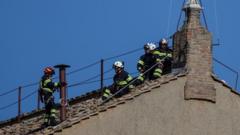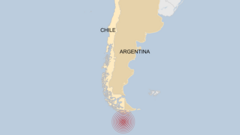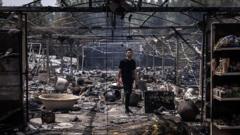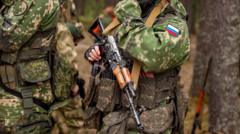Over the weekend, a series of nearly 30 wildfires erupted in southeastern South Korea, resulting in four fatalities and six injuries, as reported by local officials on Sunday. The fires, which threatened vast swathes of land, prompted massive firefighting efforts involving thousands of firefighters and numerous helicopters.
Wildfires Rage in South Korea, Claiming Lives and Forcing Evacuations

Wildfires Rage in South Korea, Claiming Lives and Forcing Evacuations
Multiple blazes devastate southeastern regions, with government declaring state of disaster as rescue efforts continue.
Officials stated that the wildfires consumed approximately 4,700 acres and led to around 1,000 residents being evacuated. The Interior Ministry revealed that train services were severely disrupted, and several roads were closed due to the flames.
On Saturday evening, authorities declared a state of disaster in the affected areas. By Sunday morning, most of the wildfires had been brought under control, with only six still active, according to the Interior Ministry.
The fatalities and injuries were predominantly linked to a significant fire that erupted in Sancheong County, roughly 160 miles southeast of Seoul, on Friday afternoon. Among the victims were at least two firefighters, with five of the injured individuals sustained serious injuries. Local officials indicated that the fire in Sancheong originated from a lawn mower operated by a farmer.
Additionally, another fire ignited in Euiseong County, approximately 110 miles southeast of the capital, early on Saturday morning, and yet another blaze started from a garbage incinerator in Gimhae, a city situated 20 miles inland from Busan.
As of Sunday morning, it was reported that the fire in Sancheong was about 30 percent contained, while the Euiseong fire was at a minimal 3 percent containment, although fire officials were optimistic about gaining control by the day's end.
Experts attribute the rapid spread of the fires to the persistent dry and windy conditions typical of South Korea during the months of March, April, and May, a phenomenon noted by the Korea Meteorological Administration.
As the region grapples with the aftermath of these wildfires, local authorities remain focused on ensuring the safety of residents and restoring normalcy.
On Saturday evening, authorities declared a state of disaster in the affected areas. By Sunday morning, most of the wildfires had been brought under control, with only six still active, according to the Interior Ministry.
The fatalities and injuries were predominantly linked to a significant fire that erupted in Sancheong County, roughly 160 miles southeast of Seoul, on Friday afternoon. Among the victims were at least two firefighters, with five of the injured individuals sustained serious injuries. Local officials indicated that the fire in Sancheong originated from a lawn mower operated by a farmer.
Additionally, another fire ignited in Euiseong County, approximately 110 miles southeast of the capital, early on Saturday morning, and yet another blaze started from a garbage incinerator in Gimhae, a city situated 20 miles inland from Busan.
As of Sunday morning, it was reported that the fire in Sancheong was about 30 percent contained, while the Euiseong fire was at a minimal 3 percent containment, although fire officials were optimistic about gaining control by the day's end.
Experts attribute the rapid spread of the fires to the persistent dry and windy conditions typical of South Korea during the months of March, April, and May, a phenomenon noted by the Korea Meteorological Administration.
As the region grapples with the aftermath of these wildfires, local authorities remain focused on ensuring the safety of residents and restoring normalcy.





















